
133Uploads
190k+Views
309k+Downloads
Chemistry

AQA A-level Atomic Structure Revision Sheet
A revision sheet for the AQA A level Atomic structure unit. Print in A4 or A3 as a revision tool prior to exams or an end of unit test

AQA Trilogy - C10 -Finite Resources
How much do we depend on the Earth’s natural resources? - A presentation that poses this question and then gets pupils to interpret graphs. Key terms and ideas are discussed

Electrolysis summary sheet
A summary of the key ideas of electrolysis for students to use as a knowledge organiser or revision sheet. I have used it for cover lessons where pupils are asked to create flash cards in lesson and then learn for homework, ready for a test next lesson.

Kinetic theory of solids, liquids and gases
A fully resourced lesson about the properties of solids, liquids and gases and how the strength of the bonding influences properties

AQA Trilogy / Chemistry - Ionic compounds
A couple of presentation that teach pupils how to draw dot and cross diagrams to represent bonding in ionic compounds and to show how the ionic lattice is formed. The resource also contains worksheet to support the working out the formula of ionic compounds. A cut out activity based on ion charge can be used to support students

AQA Trilogy / Chemistry - Metal and non-metal ions
A presentation and worksheet to take pupils through the process of ion formation in both metals and non-metals

AQA Trilogy / Chemistry - Purity
A lesson presentation with an activity to show how melting points and boiling points can be used to show purity
Bundle

AQA C8 Chemical Analysis - Trilogy
The resources to teach the trilogy chemical analysis unit including the required practical

AQA Trilogy / Chemistry - Testing for gases
A fully resourced lesson (potentially 2) to teach pupils through experiment and demo, how to test for oxygen, hydrogen, carbon dioxide and chlorine. A video is also linked to the presentation
Bundle

Revision Clocks - AQA Trilogy
A separate revision clock for each unit in the AQA trilogy course
7 Biology
9 Chemistry
7 Physics

AQA Trilogy / Chemistry - Measuring rates of reaction - graphical data
A lesson on using graphs to find the rate of reaction with accompanying assessment questions and answers

Crude oil and hydrocarbons
An introductory lesson on organic chemistry. Pupils are reminded of separation techniques used to separate mixtures and the definition of a mixture before the idea of crude oil as a mixture that needs to be separated to make it useful is introduced
Bundle

AQA Paper 2 Revision clocks
The last units for the Biology, Chemistry and Physics Paper 2s split into sub sections. Pupils are to spend no more than 4/5 minutes on each section to try and ensure that the whole of a topic is covered.

Revision clocks - Chemistry paper 2 - AQA Trilogy
The last 5 units for the Chemistry Paper 2 split into sub sections. Pupils are to spend no more than 4/5 minutes on each section to try and ensure that the whole of a topic is covered.

AQA Trilogy / Chemistry - Acids and bases
A presentation and worksheet guiding pupils through identification of the ions responsible for acidity and alkalinity and the ionic equations to describe the formation of water during neutralisation reactions. Neutralisation equations are also consider along with salt formation

Lab equipment word search
Word searches on common lab equipment. There are two versions (with answers) - one is a simpler version as it doesn’t have diagonal words or words written backwards

AQA Chemistry / Trilogy - Displacement reactions and ionic equations
A presentation to go with a practical activity to guide pupils through writing balanced symbol equations and half equations in order to identify oxidised or reduced chemical species in a displacement reaction
Bundle

AQA Paper 1 Revision clocks
The first units for the Biology, Chemistry and Physics Paper 1s split into sub sections. Pupils are to spend no more than 4/5 minutes on each section to try and ensure that the whole of a topic is covered.




















